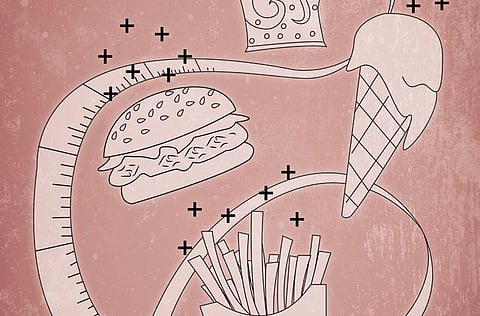Taxing one’s way to a better health for all
Surcharge on ingredients or final product can be catalyst for change for better

The UAE is the fifth-most obese country in the world, based on the consumption patterns of more than 3,000 calories a day. The country is placed 15th in the number of people living with diabetes, according to latest figures from the International Diabetes Federation.
Not only that, the risk of cardiovascular diseases are six times higher in people with diabetes. Awareness campaigns are great, but many of us can relate to people who never do abide to these. Neither do they take into their own hands the choice of following a healthier lifestyle.
The effect of such campaigns fluctuate greatly and do not necessarily achieve the desired results. So, in a unique case, like with tobacco, taxes had to be introduced in addition to banning of smoking in public places and imposing pictures of infected body organs from tobacco consumption. All of these are in full effect in the UAE and the results are yet to be observed.
In support of the argument elsewhere in the world, the percentage of smokers among adults have dropped from 43 per cent to 18 per cent in the US while smoking among teenagers is at record low, according to an op-ed in The Economist.
Taxes will, sooner or later, need to be introduced on foods or food components that directly or indirectly cause such diseases. But the question is whether the tax, if imposed, should be on final products or components.
Should we tax sugar, or chocolates, ice-cream, and candy? Should we tax oil, or should we tax burgers, fried food, and sandwiches highly saturated in fats? Pros and cons are there.
For instance, taxing mayonnaise as a component will affect the price of salad dressings and salads? Why not, since mayonnaise is not healthy regardless of its use. But taxing it means making every final product a bit more expensive.
Yes, we would want to curb its consumption, but that doesn’t mean that restaurants would like that. Norway, since 1981, has a tax of 7.05 Kroner, which is equivalent to approximately $1.128, on all refined sugar products including soft drinks. Finland introduced a tax of $0.75 per kilogram of sugar, which is estimated to levy a tax of $0.72 per quart of ice-cream.
Now this says a lot on how much sugar is used in ice-cream. Besides that, Finland introduced another tax on high-fat and high-sugar foods. Australia, in 2000, imposed a 10 per cent tax on soft drinks and bakery products. Since 1984, Samoa has had a tax on soda in an effort to reduce obesity as it ranked in the Top 10 list.
Sodas and substitutes are referred to as SSBs, short for ‘sugar-sweetened beverages’. In the Policy Brief published by Rudd Centre, a 10 per cent increase in price is estimated to lead to a decrease of 8-12.6 per cent in consumption of the SSBs. This cannot be very precise as effects will range based on how elastic any population is to price surge.
That does not mean that consumption will not decrease as a drop following a significant tax rate is inevitable. Doubts are about the magnitude of the effect, and what would be the cumulative effect with awareness campaigns and exercising more frequently.
In the case of the UAE, should taxes target components or final products? The answer is that taxes need to be on components as well as on all final products that are highly saturated in fat, sugar, and salt.
Mexico has an 8 per cent tax on the latter. Allow me to explain why. When Denmark had a tax on butter, it resulted in a 30 per cent rise in the price of butter-associated products. In the UAE, components like sugar, oil, etc need to be taxed not to only make associated products more expensive but also to address traditional UAE dishes.
A tax in the UAE should be X number for Y quantity of components, and a percentage applied to prices of final products. For final products, the application should be based on exceeding certain allowed percentage of saturated fat, sugar and salt in given products.
To avoid an effect on local producers if any local production takes place, the tax should be imposed on similar products that are being imported into the UAE. The reason is to ensure that the tax is in full effect instead of just making people switch to other unhealthy substitutes such as imported products.
Being optimistic, more expensive candy and soda drinks will affect children directly, but parents needs to take it easy with their pampering. The thought I want to leave you with is: how expensive should the product be to curb consumption?
— The writer is a commercial consultant and a commentator on economic affairs. You can follow him on Twitter at www.twitter.com/aj_alshaali.
Sign up for the Daily Briefing
Get the latest news and updates straight to your inbox



